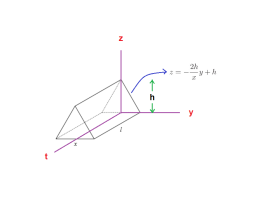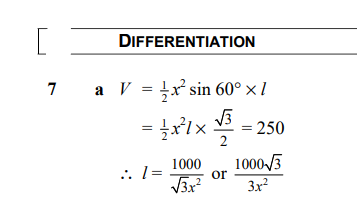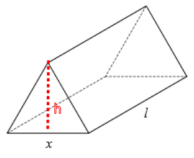You are using an out of date browser. It may not display this or other websites correctly.
You should upgrade or use an alternative browser.
You should upgrade or use an alternative browser.
Volume of triangular prism: The area of a triangular prism is 1/2*base*height*length but why did they add a sin(60)?
- Thread starter annaanna
- Start date
Are you familiar with the area formula for triangles? A prism with basearea [imath]B[/imath] and height [imath]h[/imath] always has a volume [imath]V=Bh[/imath]. However, this of course is nontrivial and requires proof. But you can still apply this formula to calculate the given volume. In this case, the base [imath]B[/imath] is the area of the equilateral triangle, and the height is [imath]l[/imath]. With this relationship, you should be able to express [imath]l[/imath] in terms of [imath]x[/imath].The area of a triangular prism is 1/2*base*height*length but why did they add a sin(60)... its an angle from the triangle but what does that have to do with this... how can you even use sohcahtoa when the angle isnt 90 degrees,, so many questions sorry if im missing something obvious View attachment 37480View attachment 37479
so the base is the base of the triangle which is 1/2*x*x then times the length, where is the sin60 coming fromAre you familiar with the area formula for triangles? A prism with basearea [imath]B[/imath] and height [imath]h[/imath] always has a volume [imath]V=Bh[/imath]. However, this of course is nontrivial and requires proof. But you can still apply this formula to calculate the given volume. In this case, the base [imath]B[/imath] is the area of the equilateral triangle, and the height is [imath]l[/imath].
Dr.Peterson
Elite Member
- Joined
- Nov 12, 2017
- Messages
- 16,087
First, of course, you meant to say "volume", not "area".The area of a triangular prism is 1/2*base*height*length but why did they add a sin(60)... its an angle from the triangle but what does that have to do with this... how can you even use sohcahtoa when the angle isnt 90 degrees,, so many questions sorry if im missing something obvious View attachment 37480View attachment 37479
But did you notice that the height of this triangle is not x?
How can you find the height, h, in terms of x, given that this is an equilateral triangle?
Notice the right triangle I've drawn.
ah my bad i actually did check to see if the height was x but I was so convinced it was while checking that I did it wrong, thank youFirst, of course, you meant to say "volume", not "area".
But did you notice that the height of this triangle is not x?
How can you find the height, h, in terms of x, given that this is an equilateral triangle?
Notice the right triangle I've drawn.
Dr.Peterson
Elite Member
- Joined
- Nov 12, 2017
- Messages
- 16,087
It's easy to accidentally tilt your head when you look for a height, isn't it?ah my bad i actually did check to see if the height was x but I was so convinced it was while checking that I did it wrong, thank you
Steven G
Elite Member
- Joined
- Dec 30, 2014
- Messages
- 14,383
You make a right triangle by simply drawing another line!how can you even use sohcahtoa when the angle isnt 90 degrees
Proof of: [imath]\displaystyle V = \frac{1}{2}xl h[/imath]

[imath]V = \displaystyle 2\int_{0}^{l}\int_{0}^{\frac{x}{2}}\int_{0}^{-\frac{2h}{x}y + h} \ dz \ dy \ dt[/imath]
[imath]= \displaystyle 2\int_{0}^{l}\int_{0}^{\frac{x}{2}} \left(-\frac{2h}{x}y + h\right) \ dy \ dt[/imath]
[imath]= \displaystyle 2\int_{0}^{l} \left(-\frac{h}{x}y^2 + hy\right)\bigg|_{0}^{\frac{x}{2}} \ dt[/imath]
[imath]= \displaystyle 2\int_{0}^{l} \left(-\frac{xh}{4} + \frac{xh}{2}\right) \ dt[/imath]
[imath]= \displaystyle 2\left(-\frac{xht}{4} + \frac{xht}{2}\right)\bigg|_{0}^{l} [/imath]
[imath]= \displaystyle 2\left(-\frac{xhl}{4} + \frac{xhl}{2}\right) [/imath]
[imath]= \displaystyle 2\left(-\frac{xhl}{4} + \frac{2xhl}{4}\right) [/imath]
[imath]= \displaystyle 2\left(\frac{xhl}{4}\right) [/imath]
[imath]= \displaystyle \frac{1}{2}xlh [/imath]
where [imath]\displaystyle h = x\sin 60^{o} = \frac{\sqrt{3}}{2}x[/imath]

[imath]V = \displaystyle 2\int_{0}^{l}\int_{0}^{\frac{x}{2}}\int_{0}^{-\frac{2h}{x}y + h} \ dz \ dy \ dt[/imath]
[imath]= \displaystyle 2\int_{0}^{l}\int_{0}^{\frac{x}{2}} \left(-\frac{2h}{x}y + h\right) \ dy \ dt[/imath]
[imath]= \displaystyle 2\int_{0}^{l} \left(-\frac{h}{x}y^2 + hy\right)\bigg|_{0}^{\frac{x}{2}} \ dt[/imath]
[imath]= \displaystyle 2\int_{0}^{l} \left(-\frac{xh}{4} + \frac{xh}{2}\right) \ dt[/imath]
[imath]= \displaystyle 2\left(-\frac{xht}{4} + \frac{xht}{2}\right)\bigg|_{0}^{l} [/imath]
[imath]= \displaystyle 2\left(-\frac{xhl}{4} + \frac{xhl}{2}\right) [/imath]
[imath]= \displaystyle 2\left(-\frac{xhl}{4} + \frac{2xhl}{4}\right) [/imath]
[imath]= \displaystyle 2\left(\frac{xhl}{4}\right) [/imath]
[imath]= \displaystyle \frac{1}{2}xlh [/imath]
where [imath]\displaystyle h = x\sin 60^{o} = \frac{\sqrt{3}}{2}x[/imath]
this is outside my league but thank you ill trust itProof of: [imath]\displaystyle V = \frac{1}{2}xl h[/imath]
View attachment 37482
[imath]V = \displaystyle 2\int_{0}^{l}\int_{0}^{\frac{x}{2}}\int_{0}^{-\frac{2h}{x}y + h} \ dz \ dy \ dt[/imath]
[imath]= \displaystyle 2\int_{0}^{l}\int_{0}^{\frac{x}{2}} \left(-\frac{2h}{x}y + h\right) \ dy \ dt[/imath]
[imath]= \displaystyle 2\int_{0}^{l} \left(-\frac{h}{x}y^2 + hy\right)\bigg|_{0}^{\frac{x}{2}} \ dt[/imath]
[imath]= \displaystyle 2\int_{0}^{l} \left(-\frac{xh}{4} + \frac{xh}{2}\right) \ dt[/imath]
[imath]= \displaystyle 2\left(-\frac{xht}{4} + \frac{xht}{2}\right)\bigg|_{0}^{l} [/imath]
[imath]= \displaystyle 2\left(-\frac{xhl}{4} + \frac{xhl}{2}\right) [/imath]
[imath]= \displaystyle 2\left(-\frac{xhl}{4} + \frac{2xhl}{4}\right) [/imath]
[imath]= \displaystyle 2\left(\frac{xhl}{4}\right) [/imath]
[imath]= \displaystyle \frac{1}{2}xlh [/imath]
where [imath]\displaystyle h = x\sin 60^{o} = \frac{\sqrt{3}}{2}x[/imath]



